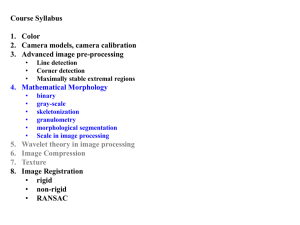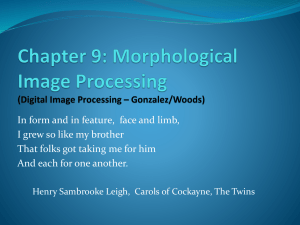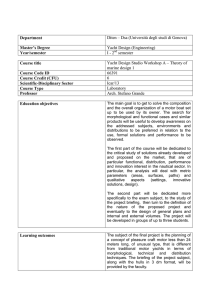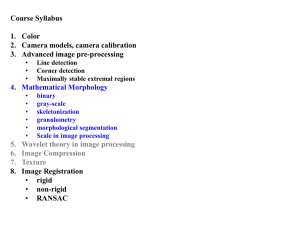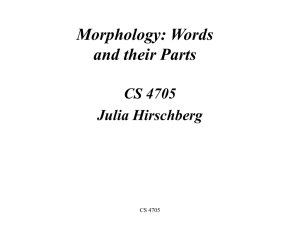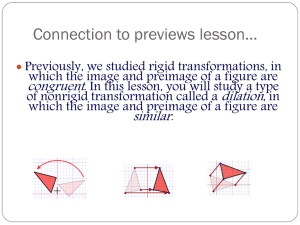Document
advertisement
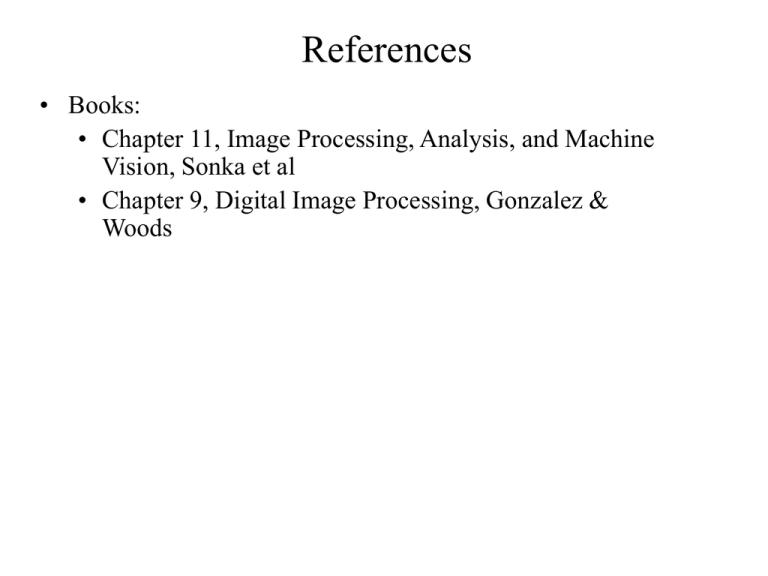
References
• Books:
• Chapter 11, Image Processing, Analysis, and Machine
Vision, Sonka et al
• Chapter 9, Digital Image Processing, Gonzalez &
Woods
Topics
• Basic Morphological concepts
• Four Morphological principles
• Binary Morphological operations
•
•
•
•
•
• Dilation & erosion
• Hit-or-miss transformation
• Opening & closing
Gray scale morphological operations
Some basic morphological operations
• Boundary extraction
• Region filling
• Extraction of connected component
• Convex hull
Skeletonization
Granularity
Morphological segmentation and watersheds
Introduction
• Morphological operators often take a binary image and a structuring
element as input and combine them using a set operator (intersection,
union, inclusion, complement).
• The structuring element is shifted over the image and at each pixel of the
image its elements are compared with the set of the underlying pixels.
• If the two sets of elements match the condition defined by the set
operator (e.g. if set of pixels in the structuring element is a subset of the
underlying image pixels), the pixel underneath the origin of the
structuring element is set to a pre-defined value (0 or 1 for binary
images).
• A morphological operator is therefore defined by its structuring element
and the applied set operator.
• Image pre-processing (noise filtering, shape simplification)
• Enhancing object structures (skeletonization, thinning, convex hull, object
marking)
• Segmentation of the object from background
• Quantitative descriptors of objects (area, perimeter, projection, EulerPoincaré characteristics)
Example: Morphological Operation
• Let ‘’ denote a morphological operator
X B { p Z | p x b, x X , b B}
2
Principles of Mathematical Morphology
• Compatibility with translation
• Translation-dependent operators
• Translation-independent operators
• Compatibility with scale change
• Scale-dependent operators
• Scale-independent operators
O ( X h ) [ h ( X )] h
( X h ) [ ( X )] h
( X ) ( 1 X )
( X ) ( X )
• Local knowledge: For any bounded point set Z´ in the transformation Ψ(X),
there exits a bounded set Z, knowledge of which is sufficient to predict
Ψ(X) over Z´.
[ ( X Z )] Z ( X ) Z
• Upper semi-continuity: Changes incurred by a morphological operation are
incremental in nature, i.e., its effect has an upper bound.
Dilation
• Morphological dilation ‘’ combines two sets using vector of set elements
X B { p Z | p x b, x X , b B}
2
If X Y then X B Y B
Erosion
• Morphological erosion ‘Θ’ combines two sets using vector subtraction of set
elements and is a dual operator of dilation
X B { p Z | b B, p b X }
2
X B { p Z | B p X }
2
If X Y then X B Y B
Duality: Dilation and Erosion
• Transpose Ă of a structuring element A is defined as follows
A { a | a A}
• Duality between morphological dilation and erosion operators
( X B)
C
X
C
B
Hit-Or-Miss transformation
• Hit-or-miss is a morphological operators for finding local patterns of pixels.
Unlike dilation and erosion, this operation is defined using a composite
structuring element B=(B1,B2). The hit-or-miss operator is defined as
follows
C
X B { x | B1 X and B 2 X }
Hit-Or-Miss transformation
Hit-Or-Miss transformation
Hit-Or-Miss transformation
Opening
• Erosion and dilation are not inverse transforms. An erosion followed by a
dilation leads to an interesting morphological operation
X
B ( X B) B
Opening
• Erosion and dilation are not inverse transforms. An erosion followed by a
dilation leads to an interesting morphological operation
X
B ( X B) B
Opening
• Erosion and dilation are not inverse transforms. An erosion followed by a
dilation leads to an interesting morphological operation
X
B ( X B) B
Closing
• Closing is a dilation followed by an erosion followed
X B ( X B ) B
Closing
• Closing is a dilation followed by an erosion followed
X B ( X B ) B
Closing
• Closing is a dilation followed by an erosion followed
X B ( X B ) B
Closing
• Closing is a dilation followed by an erosion followed
X B ( X B ) B
Gray Scale Morphological Operation
top surface
T[A]
y f ( x1 , x 2 )
Set A
x1
Support F
x2
Gray Scale Morphological Operation
• A: a subset of n-dimensional Euclidean space, A Rn
• F: support of A
F {x R
n 1
| y R s.t. ( x , y ) A}
• Top hat or surface T ( A ) : F R n
T ( A )( x ) m ax{ y | ( x , y ) A}
• A top surface is essentially a gray scale image f : F R
• An umbra U(f) of a gray scale image f : F R is the whole
subspace below the top surface representing the gray scale
image f. Thus,
U ( f ) {( x , y ) F R , y f ( x )}
Gray Scale Morphological Operation
y f ( x1 , x 2 )
top surface
T[A]
x1
x2
Gray Scale Morphological Operation
• The gray scale dilation between two functions may be defined as the
top surface of the dilation of their umbras
f k T (U ( f ) U ( k ))
• More computation-friendly definitions
f k m ax{ f ( x z ) k ( z )}
z k
f k m in{ f ( x z ) k ( z )}
z k
• Commonly, we consider the structure element k as a binary set. Then
the definitions of gray-scale morphological operations simplifies to
f k m ax{ f ( x z )}
z k
f k m in{ f ( x z )}
z k
Morphological Boundary Extraction
• The boundary of an object A denoted by δ(A) can be obtained by first
eroding the object and then subtracting the eroded image from the
original image.
( A ) A A B
Quiz
• How to extract edges along a given orientation using morphological
operations?
Morphological noise filtering
• An opening followed by a closing
• Or, a closing followed by an opening
(X
B) B
( X B) B
Morphological noise filtering
MATLAB DEMO
Morphological Region Filling
• Task: Given a binary image X and a (seed) point p, fill the region
surrounded by the pixels of X and contains p.
• A: An image where only the boundary pixels are labeled 1 and others
are labeled 0
• Ac: The Complement of A
• We start with an image X0 where only the seed point p is 1 and others
are 0. Then we repeat the following steps until it converges
X k ( X k 1 B ) A
c
k 1, 2, 3, ...
Morphological Region Filling
Ac
A
Morphological Region Filling
• The boundary of an object A denoted by δ(A) can be obtained by first
eroding the object and then subtracting the eroded image from the
original image.
A
( A ) A A B
Morphological Region Filling
X k ( X k 1 B ) ( A )
c
k 1, 2, 3, ...
Morphological Region Filling
Homotopic Transformation
• Homotopic tree
r1
h2
h1
r2
Quitz: Homotopic Transformation
• What is the relation between an element in the ith and i+1th levels?
Skeletonization
• Skeleton by maximal balls: locii of the centers of maximal balls
completely included by the object
S ( X ) { c X : r 0, B ( p , r ) closure ( X )
and r r , B ( p , r ) closure ( X )
Skeletonization
• Matlab Demo
• HW: Write an algorithm using morphologic operators to retrieve back
the portions of the GOOD curves lost during pruning
Skeletonization and Pruning
• Skeletonization preserves both
• End points
• Topology
• Pruning preserves only
• Topology
after
skeletonization
after pruning
after retrieval
Quench function
• Every location p on the skeleton S(X) of a shape X has an associated
radius qX(p) of maximal ball; this function is termed as quench
function
• The set X is recoverable from its skeleton and its quench function
X
p B ( p , q X ( p ))
p S ( X )
Ultimate Erosion
• The ultimate erosion of a set X, denoted by Ult(X), is the set of
regional maxima of the quench functions
• Morphological reconstruction: Assume two sets A, B such that B A.
The reconstruction σA(B) of the set A is the unions of all connected
components of A with nonempty intersection with B.
B
A
Ultimate Erosion
• The ultimate erosion of a set X, denoted by Ult(X), is the set of
regional maxima of the quench functions
• Morphological reconstruction: Assume two sets A, B such that B A.
The reconstruction σA(B) of the set A is the unions of all connected
components of A with nonempty intersection with B.
X B (n)
U lt ( X )
n Z
X B (n )
( X B ( n 1))
Convex Hull
• A set A is said to be convex if the straight line joining any two points
within A lies in A.
• Q: Is an empty set convex?
• Q: What ar4e the topological properties of a convex set?
• A convex hull H of a set X is the minimum convex set containing X.
• The set difference H – X is called the convex deficiency of X.
X k ( X k 1 B ) A | i 1, 2, 3, 4
i
X0 A
i
and
Xk Xk
1
2
Xk
and k 1, 2, ...
3
Xk
4
Xk
Geodesic Morphological Operations
• The geodesic distance DX(x,y) between two points x and y w.r.t. a set
X is the length of the shortest path between x and y that entirely lies
within X.
??
Geodesic Balls
• The geodesic ball BX(p,n) of center p and radius n w.r.t. a set X is a
ball constrained by X.
B X ( p , n ) { p X , d X ( p , p ) n }
Geodesic Operations
• The geodesic dilation δX(n)(Y) of the set Y by a geodesic ball of radius
n w.r.t. a set X is :
(n)
X (Y )
BX ( p, n)
p Y
• The geodesic erosion εX(n)(Y) of the set Y by a geodesic ball of radius
n w.r.t. a set X is :
(n)
X (Y ) { p Y | B X ( p , n ) Y }
An example
• What happens if we apply geodesic erosion on X – {p}
where p is a point in X?
Implementation Issue
r1 r2 B ( r1 ) Ø B ( r2 )
• An efficient solution: select a ball of radius ‘1’ and then
define
X (Y B )
(1)
X
X X ( X ( X (...)))
(n)
(1)
(1)
(1)
n tim es
Morphological Reconstruction
• Assume that we want to reconstruct objects of a given shape from a
binary image that was originally obtained by thresholding. All
connected components in the input image constitute the set X.
However, we are interested only a few connected components marked
by a marker set Y.
How?
• Successive geodesic dilations of the set Y inside the bigger set X leads
to the reconstruction of connected components of X marked by Y.
• The geodesic dilation terminates when all connected components of X
marked by Y are filled, i.e., an idempotency is reached :
n n 0 , X (Y ) X
( n0 )
(n)
(Y )
• This operation is called reconstruction and is denoted by ρX(Y).
X (Y ) lim X (Y )
(n)
n
Geodesic Influence Zone
• Let Y, Y1, Y2, ..Ym denote m marker sets on a bigger set X such that each
of Y and Yis is a subset of X.
X (Y , Y1 , Y 2 ,
Y m ) lim X (Y ) X (Y1 )
(n)
n
(n)
X (Y 2 )
(n)
X (Y m )
(n)
Reconstruction to Gray-Scale Images
• This requires the extension of geodesy to gray-scale images.
• Any increasing transformation defined for binary images can be extended
to gray-level images
X ,Y Z
2
and Y X (Y ) ( X )
• A gray level image I is viewed as a stack of binary images obtained by
successive thresholding – this process is called threshold decomposition
Tk ( I ) { p D I , I ( p ) k }
k 0,
,N
• Threshold decomposition principle
p D I , ( I )( p ) m ax{ k [0,1, ..., N ], p B (Tk ( I ))}
Reconstruction to Gray-Scale Images
• Returning to the reconstruction transformation, binary geodesic
reconstruction ρ is an increasing transformation
Y1 Y2 , X 1 X 2 , Y1 X 1 , Y2 X 2 X 1 (Y1 ) X 2 (Y2 )
• Gray-scale reconstruction: Let J, I be two gray-scale images both over
the domain D such that J I, the gray-scale reconstruction ρI(J) of the
image I from J is defined as
p D , I ( J )( p ) m ax{ k [0, N ], p Tk ( i ) (Tk ( j ))}
Reconstruction to Gray-Scale Images
I
I (J )
J
